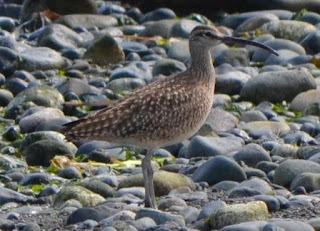 Actitis macularia
Actitis macularia Appearance:
Medium-small shorebird
Pale eyebrow and dark eyeline
White wedge up onto shoulderBreeding plumage:
- Orange bill with black tip
- Brown head, back and upperwings with small black bars
- White underparts with round, dark spots
Non-breeding plumage: (pictured below)
- Dark bill with pale base
- Pale brown head, back and upperwings with dark and buff bars
- White underparts, without dark spots
Listen to its call.
I may be dating myself but for some reason this bird made me think of the classic line from the old children's reader Fun with Dick and Jane -- "See Spot. See Spot run". It had a distinct and constant teetering motion when it walked. "Funny, funny Spot".
Learn more about the Spotted Sandpiper.
Additional pictures:
 |
| non-breeding |






































.jpg)
.jpg)



